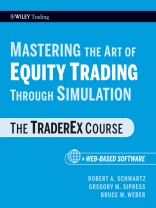An interactive guide to successfully trading in today’s
markets
Mastering the Art of Equity Trading Through Simulation is
a guidebook to interactive computer trading simulation designed to
provide participants with hands-on experience in making tactical
decisions and implementing them in different market
environments-from continuous order drive markets to call auction
markets, and from dealer markets to dark liquidity pools.
By showing traders how to operate in these different markets,
this reliable resource quickly reveals a good deal about what
trading involves and how market design impacts trading
decisions.
* Provides a virtual platform that gives users hands-on
experience in making tactical trading decisions
* Shows exactly how prices are established in the
marketplace
* Teaches how the structure of a marketplace influences
participant decisions
Learning to trade through study is like learning about a roller
coaster ride verbally. You may get the idea of going up and down
and around curves, but will lack the actual experience.
Mastering the Art of Equity Trading Through Simulation will
get you as close as possible to the markets-without actually going
in them-and prepare you to profit once you’re really there.
markets
Mastering the Art of Equity Trading Through Simulation is
a guidebook to interactive computer trading simulation designed to
provide participants with hands-on experience in making tactical
decisions and implementing them in different market
environments-from continuous order drive markets to call auction
markets, and from dealer markets to dark liquidity pools.
By showing traders how to operate in these different markets,
this reliable resource quickly reveals a good deal about what
trading involves and how market design impacts trading
decisions.
* Provides a virtual platform that gives users hands-on
experience in making tactical trading decisions
* Shows exactly how prices are established in the
marketplace
* Teaches how the structure of a marketplace influences
participant decisions
Learning to trade through study is like learning about a roller
coaster ride verbally. You may get the idea of going up and down
and around curves, but will lack the actual experience.
Mastering the Art of Equity Trading Through Simulation will
get you as close as possible to the markets-without actually going
in them-and prepare you to profit once you’re really there.
表中的内容
Foreword (Professor Dr. Reto Francioni).Preface.
How Trader Ex Works.
Who This Book is For.
Overview of the Book.
Downloading the Trader Ex Software.
How Trader Ex Works with Micro Markets.
Acknowledgements.
Part One: An Overview of Equity Market Trading.
Chapter 1: Equity Market Trading.
The Costs of Trading.
Liquidity.
Market Structure.
Informational Efficiency (or the Lack Thereof).
Expectations.
The Players.
Summary.
Chapter 2: Simulation as a Learning Tool.
Canned versus Computer Generated Prices and Quotes.
Appendix: Intertemporal Returns Correlation.
Summary.
Chapter 3: How to Use Trader Ex.
An Overview of the Trader Ex Environment.
The Continuous Order Book Market.
The Dealer Market.
Call Auctions.
Block Trading Facility.
Crossing Network.
Hybrid Markets.
Summary.
Chapter 4: Introduction to the Trading Exercises.
The Buy-Side Perspective.
The Sell-Side Intermediary Perspective.
Trader Ex Performance Measures.
Summary.
Part Two: Trader Ex Exercises.
Chapter 5: Microeconomics Goes to Market.
Exercise 5.1: The Look of a Financial Market.
Exercise 5.2: What Are Your Attitudes Toward Risk?
Exercise 5.3: Call Market Trading.
Exercise 5.4: Trading Costs in Action.
Exercise 5.5: Dealer Costs and Inventory Control.
Exercise 5.6: Inter-Market Competition for a Stock Exchange.
Exercise 5.7: Finding an Equilibrium Value.
Exercise 5.8: Economic Effects of an Order Protection Rule.
Conclusion.
Chapter 6: The Order Book Market Structure.
Exercise 6.1: Entering Limit Orders.
Exercise 6.2: Entering Market Orders.
Exercise 6.3: Adjusting Limit Orders.
Exercise 6.4: Sizing your Orders – Markets and Limits.
Exercise 6.5: Post-Trade Analysis.
Exercise 6.6: A Really Big Order.
Exercise 6.8: Illiquidity.
Exercise 6.9: Heightened Volatility.
Exercise 6.10: News and Changing Expectations.
Exercise 6.11: Endogenous Expectations.
Exercise 6.12: A One-Year Holding Period.
Exercise 6.13: Crossing Networks.
Exercise 6.14: A Networked Simulation.
Conclusion.
Chapter 7: The Call Auction Market Structure.
The Price Setting Mechanism in Trader Ex Call Auctions.
Exercise 7.1: Mechanics of the Opening Call Auction.
Exercise 7.2: Your Trader Ex Call Auction Orders.
Exercise 7.3: Your Influence on Trader Ex Call Auction Prices.
Exercise 7.4: Participating in the Opening Call Auction.
Exercise 7.5: Working a Large Order with Call Auctions.
Exercise 7.6: Proprietary Trading with Call Auction, and News Releases.
Exercise 7.7: Emphasizing Different Dimensions of Trading Performance.
Exercise 7.8: A Partially Disclosed Call Auction.
Conclusion.
Chapter 8: Dealer Markets: What Do the Trading Intermediaries Do?
Operations of Quote Driven Markets.
Exercise 8.1: Changing Quotes to Control Your Inventory.
Exercise 8.2: Market Maker Performance.
Exercise 8.3: Market Maker Risk Performance.
Exercise 8.4: Preferencing in Market Maker Systems.
Exercise 8.5: Volatility and Market Making.
Exercise 8.6: Low Liquidity and Market Making.
Exercise 8.7: Alternative Trading Systems and Market Making.
Conclusion.
Chapter 9: Dark Pools: How Undisclosed Liquidity Works.
Exercise 9.1: Mechanics of the Dark Pool.
Exercise 9.2: Seeking Advantages from Dark Pool Pricing.
Exercise 9.3: Working a Large Order with a Dark Pool.
Exercise 9.4: Proprietary Trading with Call Auction, and News Releases.
Exercise 9.5: Emphasizing Different Dimensions of Trading Performance.
Exercise 9.6: Dark Pools and Trade-Through Rules.
Conclusion.
About the Authors.
Index.
关于作者
Robert A. Schwartz is Marvin M. Speiser Professor of Financeand University Distinguished Professor in the Zicklin School of
Business, Baruch College, CUNY. He is the developer, with Bruce
Weber and Gregory Sipress, of the trading and market structure
simulation, Trader Ex.
Gregory M. Sipress is the head of software development at
Trader Ex, LLC.
Bruce W. Weber is a Professor of Information Management
at the London Business School.
语言 英语 ● 格式 EPUB ● 网页 288 ● ISBN 9780470642498 ● 文件大小 8.3 MB ● 出版者 John Wiley & Sons ● 发布时间 2010 ● 版 1 ● 下载 24 个月 ● 货币 EUR ● ID 2321637 ● 复制保护 Adobe DRM
需要具备DRM功能的电子书阅读器












